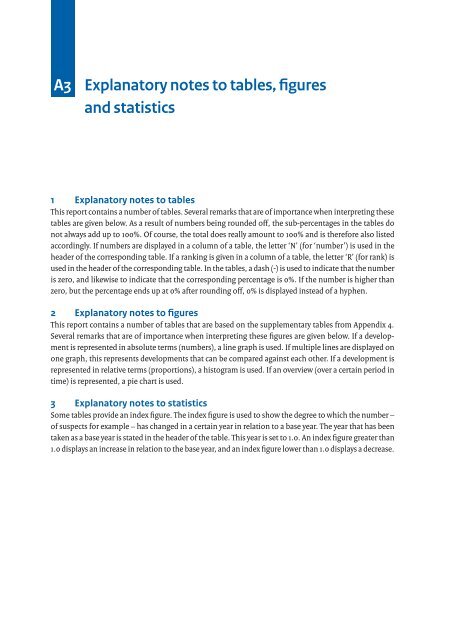Child Pornography - Home | National Rapporteur on Trafficking in ...
Child Pornography - Home | National Rapporteur on Trafficking in ...
Child Pornography - Home | National Rapporteur on Trafficking in ...
Create successful ePaper yourself
Turn your PDF publications into a flip-book with our unique Google optimized e-Paper software.
A3 Explanatory notes to tables, figures<br />
and statistics<br />
1 Explanatory notes to tables<br />
This report c<strong>on</strong>ta<strong>in</strong>s a number of tables. Several remarks that are of importance when <strong>in</strong>terpret<strong>in</strong>g these<br />
tables are given below. As a result of numbers be<strong>in</strong>g rounded off, the sub-percentages <strong>in</strong> the tables do<br />
not always add up to 100%. Of course, the total does really amount to 100% and is therefore also listed<br />
accord<strong>in</strong>gly. If numbers are displayed <strong>in</strong> a column of a table, the letter ‘N’ (for ‘number’) is used <strong>in</strong> the<br />
header of the corresp<strong>on</strong>d<strong>in</strong>g table. If a rank<strong>in</strong>g is given <strong>in</strong> a column of a table, the letter ‘R’ (for rank) is<br />
used <strong>in</strong> the header of the corresp<strong>on</strong>d<strong>in</strong>g table. In the tables, a dash (-) is used to <strong>in</strong>dicate that the number<br />
is zero, and likewise to <strong>in</strong>dicate that the corresp<strong>on</strong>d<strong>in</strong>g percentage is 0%. If the number is higher than<br />
zero, but the percentage ends up at 0% after round<strong>in</strong>g off, 0% is displayed <strong>in</strong>stead of a hyphen.<br />
2 Explanatory notes to figures<br />
This report c<strong>on</strong>ta<strong>in</strong>s a number of tables that are based <strong>on</strong> the supplementary tables from Appendix 4.<br />
Several remarks that are of importance when <strong>in</strong>terpret<strong>in</strong>g these figures are given below. If a development<br />
is represented <strong>in</strong> absolute terms (numbers), a l<strong>in</strong>e graph is used. If multiple l<strong>in</strong>es are displayed <strong>on</strong><br />
<strong>on</strong>e graph, this represents developments that can be compared aga<strong>in</strong>st each other. If a development is<br />
represented <strong>in</strong> relative terms (proporti<strong>on</strong>s), a histogram is used. If an overview (over a certa<strong>in</strong> period <strong>in</strong><br />
time) is represented, a pie chart is used.<br />
3 Explanatory notes to statistics<br />
Some tables provide an <strong>in</strong>dex figure. The <strong>in</strong>dex figure is used to show the degree to which the number –<br />
of suspects for example – has changed <strong>in</strong> a certa<strong>in</strong> year <strong>in</strong> relati<strong>on</strong> to a base year. The year that has been<br />
taken as a base year is stated <strong>in</strong> the header of the table. This year is set to 1.0. An <strong>in</strong>dex figure greater than<br />
1.0 displays an <strong>in</strong>crease <strong>in</strong> relati<strong>on</strong> to the base year, and an <strong>in</strong>dex figure lower than 1.0 displays a decrease.


